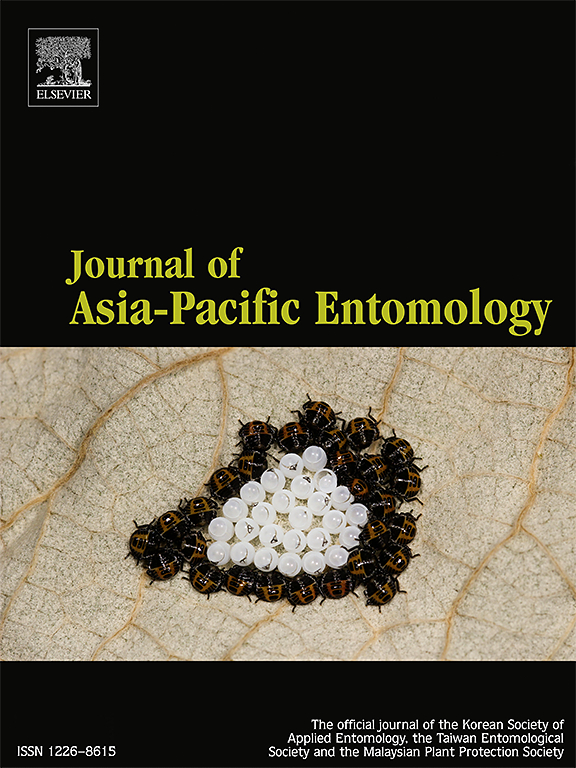Ribavirin showed insect growth regulator activity to Helicoverpa armigera
IF 1.3
3区 农林科学
Q3 ENTOMOLOGY
引用次数: 0
Abstract
Ribavirin is a nucleoside analog used to control virus disease clinically. In this study, toxicity determination, transcriptome analysis and ELISA were employed to explore its toxicity and potential mechanism on Helicoverpa armigera larvae. Results suggested that ribavirin showed stomach toxicity to H. armigera, but low contact toxicity. Chemicals 1,2,4-triazole and 1,2,4-triazole-3-carboxamide showed low stomach toxicity to H. armigera, indicating 1,2,4-triazole and furanose were both the key chemical structure to ensure the larvicidal activity of ribavirin. Transcriptome and qRT-PCR results validated that ribavirin treatment inhibited the expression of genes in chitin biosynthesis, lipid biosynthesis and cuticle protein genes. Ribavirin treatment also decreased the Juvenile Hormone (JH) titer, but showed no influence to ecdysone titer. These results indicated that ribavirin treatment inhibited JH biosynthesis and interfered new cuticle formation, which resulted to the failure of H. armigera larvae molting and normal pupation. These results provided a novel lead compound for IGR development to control H. armigera.

利巴韦林对棉铃虫具有昆虫生长调节剂活性
利巴韦林是临床上用于控制病毒病的核苷类似物。本研究采用毒力测定、转录组分析和酶联免疫吸附试验,探讨其对棉铃虫幼虫的毒力及其潜在机制。结果表明,利巴韦林对棉铃虫有胃毒性,但接触毒性较低。化学成分1,2,4-三唑和1,2,4-三唑-3-羧酰胺对棉铃虫的胃毒性较低,说明1,2,4-三唑和呋喃糖都是保证利巴韦林杀幼虫活性的关键化学结构。转录组和qRT-PCR结果证实,利巴韦林抑制了几丁质生物合成、脂质生物合成和角质层蛋白基因的表达。利巴韦林治疗也降低了少年激素(JH)滴度,但对脱皮激素滴度没有影响。这些结果表明,利巴韦林抑制了JH的生物合成,干扰了新角质层的形成,导致棉铃虫幼虫无法正常蜕皮和化蛹。这些结果为IGR的开发提供了一种新的先导化合物。
本文章由计算机程序翻译,如有差异,请以英文原文为准。
求助全文
约1分钟内获得全文
求助全文
来源期刊

Journal of Asia-pacific Entomology
Agricultural and Biological Sciences-Insect Science
CiteScore
2.70
自引率
6.70%
发文量
152
审稿时长
69 days
期刊介绍:
The journal publishes original research papers, review articles and short communications in the basic and applied area concerning insects, mites or other arthropods and nematodes of economic importance in agriculture, forestry, industry, human and animal health, and natural resource and environment management, and is the official journal of the Korean Society of Applied Entomology and the Taiwan Entomological Society.
 求助内容:
求助内容: 应助结果提醒方式:
应助结果提醒方式:


